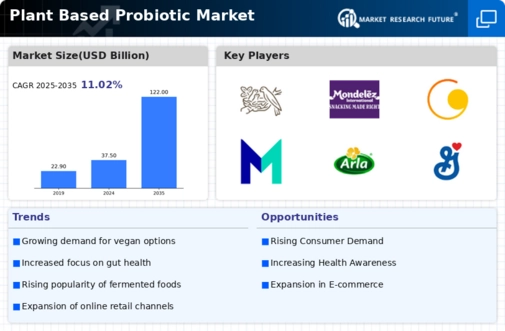Market Growth Projections
Rising Health Consciousness
The increasing awareness of health and wellness among consumers is a pivotal driver for the Global Plant Based Probiotic Market Industry. Individuals are progressively seeking natural alternatives to enhance gut health and overall well-being. This trend is reflected in the growing demand for plant-based probiotics, which are perceived as a healthier option compared to traditional dairy-based probiotics. As of 2024, the market is valued at approximately 37.5 USD Billion, indicating a robust consumer shift towards plant-based dietary supplements. This health consciousness is likely to propel the market further as consumers prioritize products that align with their health goals.
Sustainable and Ethical Consumption
The Global Plant Based Probiotic Market Industry is experiencing a surge in demand driven by the growing emphasis on sustainability and ethical consumption. Consumers are increasingly concerned about the environmental impact of their food choices, prompting a shift towards plant-based products. This trend is particularly pronounced among younger demographics who prioritize eco-friendly and cruelty-free options. The market's projected growth to 122.0 USD Billion by 2035 underscores the potential for plant-based probiotics to meet these consumer demands. Companies that adopt sustainable practices are likely to gain a competitive edge in this evolving landscape.
Diverse Product Offerings and Innovations
The Global Plant Based Probiotic Market Industry is characterized by a diverse range of product offerings, including capsules, powders, and functional foods. This variety caters to different consumer preferences and lifestyles, enhancing market accessibility. Innovations in product formulations, such as the incorporation of superfoods and adaptogens, are also driving interest in plant-based probiotics. As brands continue to introduce new and unique products, they are likely to capture the attention of health-conscious consumers. This dynamic product landscape is expected to contribute to the market's growth trajectory, aligning with the overall trend of increasing consumer engagement.
Technological Advancements in Fermentation
Innovations in fermentation technology are significantly influencing the Global Plant Based Probiotic Market Industry. Advances in microbial research and fermentation processes enable the development of more effective and diverse probiotic strains derived from plant sources. These technological improvements enhance the efficacy and stability of plant-based probiotics, making them more appealing to consumers. As the market evolves, the introduction of novel formulations and delivery methods is expected to attract a broader audience. This trend aligns with the anticipated compound annual growth rate of 11.31% from 2025 to 2035, indicating a promising future for the industry.
Increasing Prevalence of Digestive Disorders
The rising incidence of digestive disorders globally is a significant driver for the Global Plant Based Probiotic Market Industry. Conditions such as irritable bowel syndrome and inflammatory bowel disease are becoming more common, leading consumers to seek effective solutions. Plant-based probiotics are often regarded as a natural remedy for these ailments, contributing to their growing popularity. The market's expansion is further supported by healthcare professionals recommending probiotics as part of a holistic approach to digestive health. This trend suggests a sustained demand for plant-based probiotics as consumers increasingly prioritize gut health.
























